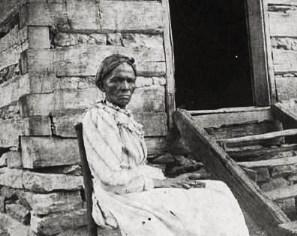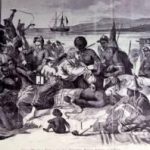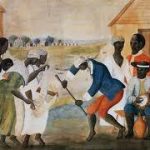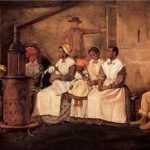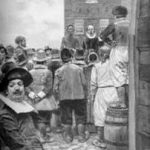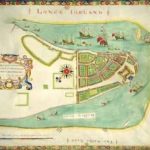Women Slaves in the Colony of Virginia
Slavery is a civil relationship in which one person has absolute power over the fortune, life and liberty of another. Chattel slavery further defines that relationship with the added dimension of ownership as personal property (chattel), in which the chattel can be bought and sold as if they were commodities. Chattel slavery was legal in the American colonies from the mid-17th century to the end of the Civil War in 1865.
A slave is a human being who is forced to obey the commands of others, and to work for nothing. A chattel slave is an enslaved person who is owned forever and whose children and children’s children are automatically enslaved as well. A chattel slave has no rights, and is no longer viewed as a human being, but as an object used to accomplish a task, like any other tool.
Jamestown
The earliest documented African women in North America were three women who, along with 17 men, were brought to Jamestown by a Dutch ship in 1619. These 20 Africans were indentured servants, which meant that they were to work for a set period of time, in exchange for the cost of their transportation to the New World and room and board.
After the terms of their indenture were fulfilled, these servants were given their freedom and assigned some land, and were thereafter considered free Negroes. In 1624 it was recorded that an African woman named Isabel gave birth to William, the first documented African American child born in Jamestown.
An early court decision in 1640 marked a change in Virginia’s attitude toward Africans. In 1640, three Virginia servants – two Europeans and one African – ran away from their masters. Upon recapture, a Virginia judge ordered the European servants to serve their master for one more year; the African servant was ordered to serve his master for the rest of his life.
In the ensuing years, Virginia passed laws that severely restricted the rights of African slaves and expanded the rights of their owners. Each of the thirteen colonies eventually enacted similar laws that recognized the enslavement of Africans. Most of the first African slaves were captured in their homeland by the Dutch or by fellow Africans.
Producers and Reproducers
As early as 1662, African American women were doubly valued: for their work in the field and in the household, and for their ability to have children, which expanded the labor force with less cash spent up-front. The desire to import women for that dual purpose led the colony of Virginia to pass a law in 1662, which stated that the legal status of a child would be determined by the status of the mother. If the mother was a slave, then her child was doomed to slavery.
The slave trade so increased the African slave population in America that by the late 1600s, colonists were beginning to worry about slave revolts. Slaves resisted their servitude by running away, fighting back and poisoning food. By 1750, populations of displaced Africans would range from an estimated 550 in New Hampshire to over 101,000 in Virginia.
A Virginia law passed in 1670 defined as slaves-for-life all non-Christian servants who arrived at the colony “by shipping,” which were, almost without exception, Africans. From 1700 to 1740 an estimated 43,000 slaves were imported into Virginia, and all but about 4,000 were imported directly from Africa. Historians have now discovered that the number of women and men imported was more or less equal, as well as a high number of children.
West African women’s cultures played a central role in mid- to late-eighteenth-century slave life in Virginia, particularly the powerful bond between mother and child, as well as the connection between females within a community. In general, Africans came from a diverse range of cultural backgrounds, virtually all of which had powerful women’s communities, which were then introduced into a patriarchal and racist society.
Mary Aggie
A slave belonging to widow Anne Sullivan, a tavern keeper in Williamsburg, Virginia, Mary Aggie sued for freedom from her owner in 1728. Her trial was presided over by Lt. Governor William Gooch. Although unsuccessful in winning her freedom in 1728, she demonstrated her belief in Christianity to the satisfaction of the judge.
In 1730 Mary Aggie was charged with stealing from her owner, and Lt. Governor Gooch sent one of his attorneys to observe her trial. On November 7, 1730, Aggie was convicted of stealing three sheets valued at forty shillings from her owner. This sort of crime was typically punished by death or severe corporal punishment.
Learning from his lawyer that Aggie had been convicted, Gooch arranged for her case to be transferred to the General Court, where he hoped she could plead benefit of clergy, a privilege in English law dating back centuries that allowed a person to escape death or other severe penalty on a first conviction for most capital offenses.
Benefit of clergy was originally used to grant immunity to members of the clergy who were accused of capital offenses. Later, anyone having the remotest relationship to the church could also enter this plea. Because she had convinced him in her first trial that she believed in Christianity, Gooch believed that Aggie might be entitled to benefit of clergy if she were not a slave.
On May 6, 1731, before a final verdict could be rendered by the General Court, Gooch and the Governor’s Council, sitting in executive session, pardoned Mary Aggie “upon condition that she be transported out of this Colony to Some other of his Majesties plantations there to be sold as a Slave.”
Gooch saved Aggie’s life, but left the question of whether slaves were entitled to use the plea unanswered. Referring to her court case and subsequent pardon, the Virginia General Assembly passed a law on July 1, 1732, which allowed virtually all convicted felons – whites, women, Indians, mulattos and African Americans – to plead benefit of clergy except in certain cases.
Unfortunately, the law also added to the list of felonies for which a defendant could not plead benefit of clergy. What it granted in some clauses in the names of mercy and justice, it took away in others for the protection of the institution of slavery and the property of slaveholders. The new law also denied to all Indians and persons of African descent the right to give testimony in court except “upon the trial of a slave, for a capital offense.”
Mary Aggie is an obscure person in history, but her case earned her a place in history. As a result of her actions, and those of William Gooch and the General Assembly, for more than sixty years all Virginians enjoyed the right to plead benefit of clergy on a first conviction. After 1796 they retained some limited rights to make the plea, until it was abolished in 1849.
SOURCES
Encyclopedia Virginia: Mary Aggie
Encyclopedia Virginia: Virginia’s First Africans
Wikipedia: Female Slavery in the United States
